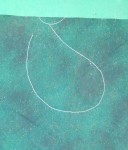| I’ve developed a technique for really intricate and accurate applique without the need for iron-on or glue adhesive. This machine pinning and basting method holds everything together in the correct relationship from start to finish, allowing hand-applique of designs that previously were only possible using iron on applique. As a bonus, it’s very simple and great for people new to hand applique.
I used this technique for the fish on the back of the Ichthy Bog Coat (closeup image), a fussy bit of applique with 16 separate pieces of fabric that had to be held in the correct orientation for the fish to come to life. |
|
| This method produces beautifully flat applique. It looks like it’s been ironed on without being ironed on. The horse head work you’re seeing here hasn’t been pressed though it looks as if it has. Yup, it’s that flat. The only limitation is that of the weaving of the applique fabric. The more finely woven the fabric, the skinnier the stem or trace possible. The horse head is done in batik which can hold up to narrow traces and skinny stems. | |
| The seeds of this technique started with the background of the koi pond web quilt. The medium blue was a cotton jacquard (bubbles) that proved to be an unmannerly beast to flip and sew. Using butcher paper was completely out. Removing the butcher paper would distort and damage the fabric. After machine basting, it was a sweet and happy puppy. The quilt came out beautiful in appearance and workmanship.
With this method I can do curves, points, valleys, narrow lines . . . the works, and have it come out beautiful, clean and accurate. This technique is faster than most other methods of preparing hand applique, no tracing or transferring patterns to fabric, no cutting out and ironing on butcher paper shapes, no purchasing commercial templates. By working off a sacrificial copy of the pattern, every piece ends up exactly where it should in relation to all the others. There is no additional prep which makes this technique fast and accurate. This technique can also be used for reverse applique. |
So here we go, in text and pictures, machine-basting for hand applique.
Select a sturdy pattern paper. The paper must be sturdy without being thick. My preferred pattern paper is Tyvek. For smaller less complicated designs, copy paper works adequately. For larger uncomplicated designs, good quality blank news print works. Do not use a light easily torn paper like vellum or tissue paper. You can use butcher paper if you must but take care that you don’t iron your work until the pattern paper has been removed. The back of quality wrapping paper is good but a piece of reinforced paper (Tyvek) is a must for a big and/or complicated design. Save Tyvek envelopes to use for smaller designs or see if you can get a small patch roll of Tyvek from your local building center. You can cut sheets from it to run through a copy machine or printer.
Transfer your design in reverse onto your pattern paper. This is the only time you’ll need to transfer the pattern. If you plan to do a whole quilt top, you can cut the pattern into manageable sections and work one section at a time. This will require adding pattern registration marks before the pattern is sectioned. Transfer those registration marks to the fabric background so each subsequent pattern piece can be accurately positioned.
If you are doing a complex multi-layered design, the parts can be appliqued into a whole off the background fabric and appliqued onto the background once fully assembled. This is how the fish on the Ichthy Bog Coat was done. The design was printed on copy paper, all the fins, eyes and accents appliqued to the fish background and then appliqued to the body of the coat.
This technique is a great skill in your toolbox but it’s isn’t universally applicable. It is a marvelous technique for complex multi-part applique and designs that have, until now, been restricted to iron on applique.















Your instructions are clear, but for demo purposes, I would have liked to see you use a contrasting thread for your baste stitch.
Also, I will need to work through it to get it.
Corene said the same thing. I’ll do another set of photos with contrasting thread.
Thank you for this bright idea ! all is clear in demonstration. I’m about to a new appliqué with cat’s head and sure will try yr method.
arlette
Dear Nori, thank you for posting such a fantastic appliqué method. It was very generous of you to make your technique freely available.
I do have a query regarding the final steps involving handsewing.
Do you turn the edge of the appliqué pieces as you trim them towards the machine stitching line or do you sew an appliqué overcast stitch over the edge of each trimmed area?
I would really appreciate some additional advice regarding the method of stitching you are using.
Thanks, Jessica
The edges are turned ON the machine stitching line. The holes from the machine stitching cause the fabric to easily fold giving a clean break to the fabric. As the machine stitching is picked out the fabric is turned under and appliqued down.
Thanks for this Nori. Good instructions and once I’ve read it again and actually followed the method, it will make total sense to me. I am a ‘hands on’ person, sometimes the written word takes me a bit to process.
I will get a detailed video done this summer. It’s such an awesome technique, so simple with a beautiful result.